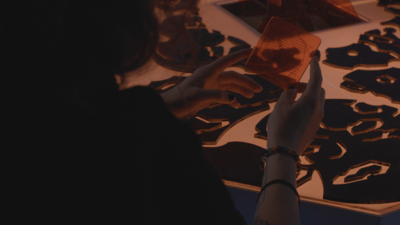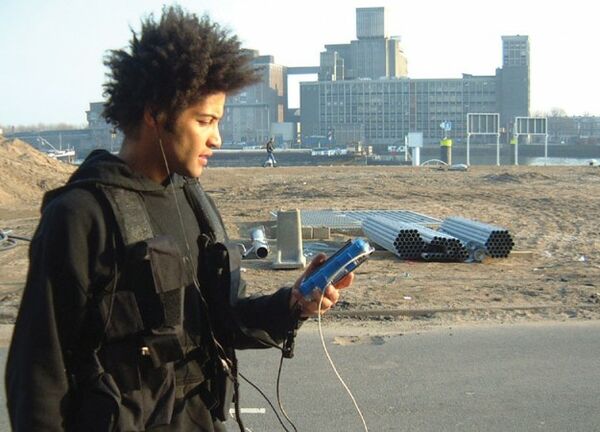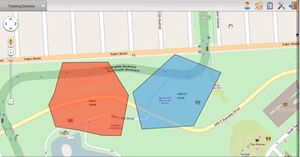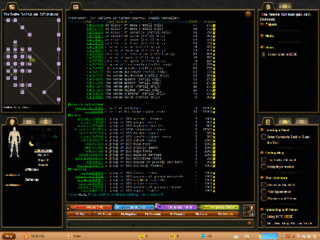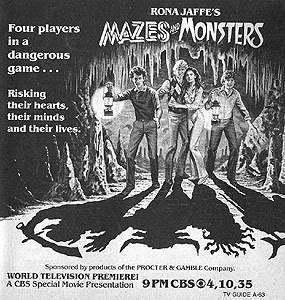EtherAxis: Difference between revisions
No edit summary |
|||
| Line 21: | Line 21: | ||
28th November & 5th December 2021. | 28th November & 5th December 2021. | ||
Sickhouse, Enschede. | Sickhouse, Enschede. | ||
[https://www.theoverkill.nl/program-game.html#erik The Overkill Festival] | |||
==About== | ==About== | ||
Revision as of 13:16, 16 November 2021
28th November & 5th December 2021. Sickhouse, Enschede. The Overkill Festival
About
EtherAxis is an interactive game installation and reflection tool aiming to challenge the inner paradigms that shape our perception of realities. The physical relic that forms the base for this game shape-shifts in different contexts. The structure of the gameboard emphasises four main axes, each connected to multiple ancient symbols of alchemy, hacked to uncover their original meanings. In this constellation of four interlaced geographic grids, the dreamer wanders through bridging fields on a spatiotemporal axis. Throughout the Overkill, EtherAxis lures you into the streets to find its messages hidden in plain sight, stepping over to the worlds floating in the ether.
EtherAxis is the result of an ongoing collaboration between Camilo García A., Emilia Tapprest, Erik Peters, Federico Poni, Louisa Teichmann & Victor Evink, as part of the Hamburger Community of Live & Art trajectory of Roodkapje, with performances by Queer Arcana.
Introduction
Invisible Borders
Video Game techniques of hiding the map borders, integrating limits of map and unnreachable areas as part of storyline.
in XR, geographical markers are translated into fictional environment to make sure players are not walking against walls or outside of playing field -> wall could look like abyss
“A crucial feature of Blast Theory projects is the ability to extend user and audience affect outside the game - rather than delimiting our consciousness to the stereotypical and virtual, the gameplay pushes us to understand aspects of ourselves, our communities and social responsibility. This is partially achieved by the very visceral gameplay - in CYSMN? the players and gameplay self-generate affects of pursuers and pursued. ... It was encouraging to see Blast Theory awarded the Prix Ars Electronica Golden Nica, which has in the past lauded some commercial, apolitical projects.”
Quote credit: RealTime magazine, Dec03/Jan04 https://www.blasttheory.co.uk/projects/can-you-see-me-now/
Geofencing
Location-based advertisement
"A geofence is a virtual perimeter for a real-world geographic area. A geo-fence could be dynamically generated (as in a radius around a point location) or match a predefined set of boundaries (such as school zones or neighborhood boundaries).
The use of a geofence is called geofencing, and one example of use involves a location-aware device of a location-based service (LBS) user entering or exiting a geo-fence. This activity could trigger an alert to the device's user as well as messaging to the geo-fence operator. This info, which could contain the location of the device, could be sent to a mobile telephone or an email account." [2]
Chapter 2: Take a Leap in the Dark
[2000 words]
Bright Screens & Dark Patterns
"Types of Dark Patterns
❃Bait and Switch.
❃Disguised Ads.
❃Forced Continuity.
❃Friend Spam.
❃Hidden Costs.
❃Misdirection.
❃Price Comparison Prevention.
❃Privacy Zuckering." [1]
The Age of Surveillance Capitalism ~ Shoshana Zuboff
Interactive Fiction meets Surveillance Capitalism:
Surveillance Capitalism spilling into the city streets, leading you to where the algorithm thinks you should be going.
Chapter 3: The Game
[2600 words]
pre-game
Forming a progressive storyline
Geographical markers connect alternate spaces. Playing the game results in subtle changes in public spaces of city
Game adapting to the way its being played.
Creating a visual language and communication methods
Play Tests
Development Week TETEM
January or March
in-game
Documentation of actual Gameplay.
post-game
Analysis. I am planning to review the different game methods I have tested and applied and in what ways they have supported the progression of the narrative through lived experience. Based on the results of this analysis I will suggest areas of improvement and propose a future set-up of the game.
Conclusion
[500 words]
Based on my research on methods of location-based advertisement, I will formulate my vision of its potential and dangers, picturing a ludified smart city and celebrating ways of dancing on the structures of its system.
Bibliography
Books
This is not a Game ~ Dave Szulborski
The Case Against Reality ~ Donald Hoffman
The Age of Surveillance Capitalism ~ Shoshana Zuboff
Space Time Play http://www.spacetimeplay.org/
Tactical Tech https://ourdataourselves.tacticaltech.org/posts/inside-the-influence-industry/
Articles
http://aaaan.net/blast-theory-2/
https://en.wikipedia.org/wiki/Location-based_game
https://www.playtoearn.online/category/blockchain-gaming/
https://whatis.techtarget.com/definition/geofencing
Games
Blast Theory: Can you see me now? 2001. https://en.wikipedia.org/wiki/Can_You_See_Me_Now%3F
Tomo Kihara: Escape the Smart City, 2018.
Roos Groothuizen: I want to delete it all, but not now. 2021.
Collaborators (to be confirmed)
Emilia Tapprest (film maker and performer)
"nvisible.studio is the independent research practice of Finnish designer and filmmaker Emilia Tapprest (b. 1992). She is currently enrolled at Filmforward’s Virjplaats residency and Stimuleringsfonds’ Talent Development programme 2021-22. Her research explores the role of value paradigms in emerging technocultural developments through worldbuilding and cinema, working closely with historian and music producer Victor Evink (S x m b r a). Their works as a duo Liminal Vision tackle themes such as human connectedness and agency in the quantified age, exploring how a system's underlying logic produces particular ‘affective atmospheres’ in interaction with its social fabric."
Tomo Kihara (game designer)
My name is Tomo Kihara — research driven designer making playful interventions that provides a new perspective to complex socio-technical problems.
Roos Groothuizen (artist & designer)
My name is Roos Groothuizen. I am an independent media artist and designer who dances on the borders of interaction, theater, intervention, web, film, games and animation.
Who is in control over what I perceive? Fascinated with the unfair distribution of information and how online algorithms systematically discriminate us, my work reflects on in-depth research and recent developments, often with interactive or game-like elements. Fun with a serious undertone.
Further Reading
Mazes & Monsters by Rona Jaffe
Appendix
Game Narrative
Climb the Firewall, 2020
Earthrise, 2021
"I had to smile when I saw you, holding that mobile phone in your hand, big and heavy. You remind me of myself, many years ago. I should feel nostalgic for those years, but I feel anxious for you. For what is yet to come, until we finally meet again. Back in the 2020s, I was one of the gamers who started living entirely off of data provision, when the data ownership lawsuit guaranteed millions of internet users a constant flow of income. It was really: “The more you interact, the more you get paid.” and that came easy for me. I spent my teenage years consumed by video games, I would get drawn into the beauty of the digital landscapes and somehow, the thought that someone created it, thought of every detail and placed every single object with a purpose, made me feel a sense of intimacy and connection. I dedicated all of my attention to my favourite games and eventually gained international success by joining the esports team Dolphin Waves. The recognition I received for my performance was unimaginable and made me feel like I was floating above the world. But something felt off. I could never feel complete with the pressure of success and the real time ticking in the back of my mind. When I started to get paid for my time spent interacting in the metaverse, I would spend the money on minted in-game items and the worlds would get better and better.
Do you see the skyscrapers on the side of the water? What you are seeing is the vertical city. It was built to accommodate any need inside one massive structure, reaching only upwards. In your time, there were still many offices next to the living spaces. In the late 20s, a tech spa opened on one of the floors, with a small number of flotation tanks connected to the VR game Dream Chaser. The first time I tried it, I could never look back. It was like something clicked and I realised, this is all I need. I started investing most of my pay into XR, and with me many others, which finally allowed for completely invisible tech. Do you see the floating pavilion? Three translucent domes, interconnected to create a sheltered platform. In 2021, it became abandoned due to the covid-19 pandemic and was up for rent to anti-squatters for a while. Its best days as an event space were long gone, once the vertical city bought it as a part of their XR program. Look inside? Seems empty, doesn’t it? Well, it’s not, but you can not see it. It is a worlding space, we use it to move around in our hyper-individualised landscapes. We all see different things. It becomes exciting when we share the space. At the moment someone joins the space, they become non-playable characters in each other’s worlds, matching the aesthetics of the other. How, do you ask? We connected our brainwaves to a massive computer network run in the harbour. Everything is completely intuitive. The beauty of it is, now I am the creator of the landscape, and everyday, I am rediscovering myself inside of it.
(Earthrise, May 2021)

